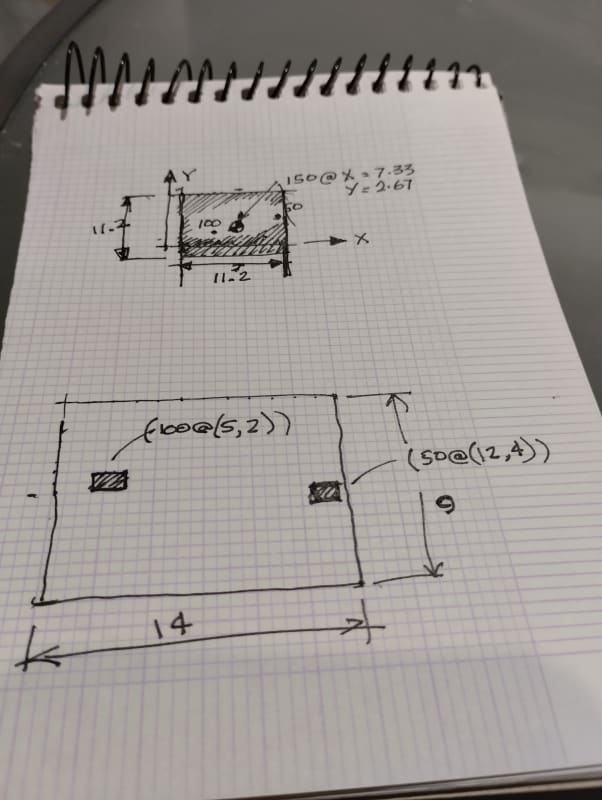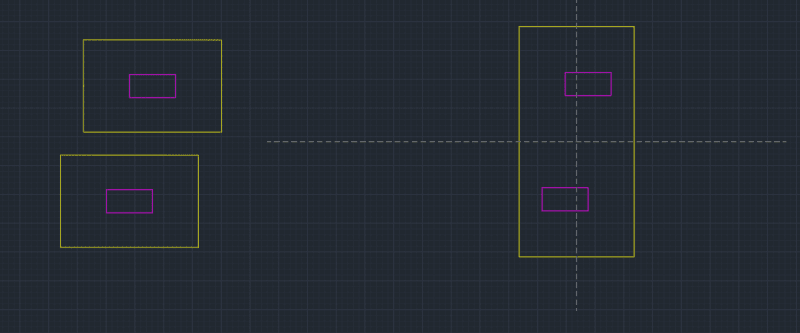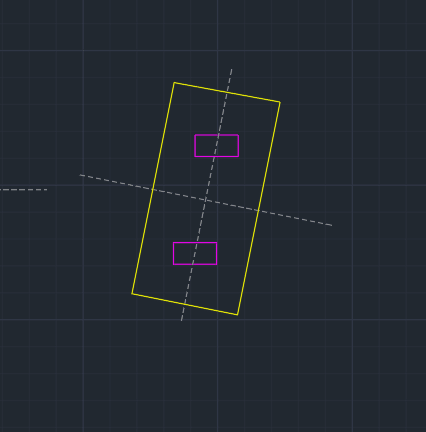Navigation
Install the app
How to install the app on iOS
Follow along with the video below to see how to install our site as a web app on your home screen.
Note: This feature may not be available in some browsers.
More options
Style variation
-
Congratulations cowski on being selected by the Eng-Tips community for having the most helpful posts in the forums last week. Way to Go!
You are using an out of date browser. It may not display this or other websites correctly.
You should upgrade or use an alternative browser.
You should upgrade or use an alternative browser.
Columns not on the same line for Combined Footing
- Thread starter Annie124
- Start date
- Status
- Not open for further replies.
Find the centroid of your dead loads.
Locate the centroid of your footing at the same place.
Make its area large enough so that allowable soil bearing is not exceeded.
Make the footing thick enough to be rigid. At least about 10% of the longest dimension.
Check the footing thickness for punching shear. Increase thickness as necessary.
Long dimension steel.
Find the max bending moment in the long dimension due to all load conditions.
Size long bar diameter.
Short dimension steel.
Consider each column independently and, using a width of column width + 2x footing depth,
Find the max bending moment in the short dimension due to all load conditions.
Size short dimension bar diameter.
If bar size at column 1 is similar to column 2, use the largest bar diameter everywhere in the short dimension.
--Einstein gave the same test to students every year. When asked why he would do something like that, "Because the answers had changed."
Locate the centroid of your footing at the same place.
Make its area large enough so that allowable soil bearing is not exceeded.
Make the footing thick enough to be rigid. At least about 10% of the longest dimension.
Check the footing thickness for punching shear. Increase thickness as necessary.
Long dimension steel.
Find the max bending moment in the long dimension due to all load conditions.
Size long bar diameter.
Short dimension steel.
Consider each column independently and, using a width of column width + 2x footing depth,
Find the max bending moment in the short dimension due to all load conditions.
Size short dimension bar diameter.
If bar size at column 1 is similar to column 2, use the largest bar diameter everywhere in the short dimension.
--Einstein gave the same test to students every year. When asked why he would do something like that, "Because the answers had changed."
- Thread starter
- #3
Very creative, but it helps reduce complexity both in analysis and construction, if you keep foundation lines aligned to one X, Y coordinate system.
Do you know how to replace two forces (here the dead loads) with one resultant force?
Dead
Load, X, Y
100, 5, 2
50, 12, 4
X location
X = (100 x 5 + 50 x 12)/(100 + 50)
Y = (100 x 2 + 50 x 4)/(100 + 50)
X= 1100/150 = 7.33
Y= 400/150 = 2.67
Try footing thickness of 2
(Pressure of concrete in footing)
Unit weight of concrete = 0.5
Footing pressure = 2 x 0.5 = 1
Allowable soil bearing pressure = 2.2
Footing pressure 1
Dead load Min Footing Area = 150/(2.2-1)
Dead load Min Footing Area = 150/1.2 = 125
For now I'd just assume a square Footing.
Magnitude of wind in X and Y directions may affect dimensions later.
Square Footing Dimensions (125)^0.5 = 11.2 x 11.2
11.2÷2 = 5.6
Edges of Square Footing
Xmin = 7.33 - 5.6 = 1.73
Xmax = 7.33 + 5.6 = 12.93
Ymin = 2.67 - 5.6 = -2.93
Ymax = 2.67 + 5.6 = 8.27
Adjust dimensions, because the 50 load at 12 is too close to Footing edge at 12.93
Try 14 x dimension
Y dimension 125/14 = 8.92, say 9
Area = 126, > 125 OK
Xmin = 7.33 - 7 = 0.33
Xmax = 7.33 + 7 = 14.33
Ymin = 2.67 - 4.5 = -1.83
Ymax = 2.67 + 4.5 = 7.17
Check other load conditions
--Einstein gave the same test to students every year. When asked why he would do something like that, "Because the answers had changed."
Do you know how to replace two forces (here the dead loads) with one resultant force?
Dead
Load, X, Y
100, 5, 2
50, 12, 4
X location
X = (100 x 5 + 50 x 12)/(100 + 50)
Y = (100 x 2 + 50 x 4)/(100 + 50)
X= 1100/150 = 7.33
Y= 400/150 = 2.67
Try footing thickness of 2
(Pressure of concrete in footing)
Unit weight of concrete = 0.5
Footing pressure = 2 x 0.5 = 1
Allowable soil bearing pressure = 2.2
Footing pressure 1
Dead load Min Footing Area = 150/(2.2-1)
Dead load Min Footing Area = 150/1.2 = 125
For now I'd just assume a square Footing.
Magnitude of wind in X and Y directions may affect dimensions later.
Square Footing Dimensions (125)^0.5 = 11.2 x 11.2
11.2÷2 = 5.6
Edges of Square Footing
Xmin = 7.33 - 5.6 = 1.73
Xmax = 7.33 + 5.6 = 12.93
Ymin = 2.67 - 5.6 = -2.93
Ymax = 2.67 + 5.6 = 8.27
Adjust dimensions, because the 50 load at 12 is too close to Footing edge at 12.93
Try 14 x dimension
Y dimension 125/14 = 8.92, say 9
Area = 126, > 125 OK
Xmin = 7.33 - 7 = 0.33
Xmax = 7.33 + 7 = 14.33
Ymin = 2.67 - 4.5 = -1.83
Ymax = 2.67 + 4.5 = 7.17
Check other load conditions
--Einstein gave the same test to students every year. When asked why he would do something like that, "Because the answers had changed."
- Thread starter
- #5
The centroid of the footing is always placed under resulting dead load to minimize differential settlements for sustained loads. You may also want to include live loads (or reduced live loads in this centroid calculation, as they should not be too conservative. But use dead plus full live load for the soil bearing check,)
This is the arrangement for my loads.

You may need to adjust further to get reasonable effective strip widths and a good distribution of steel in the x and y directions, such as when columns are too close to the edge of footings, reducing your effective width too much.
Wind loads may alter your dimensions, especially if wind loads in X direction are greatly different than Y. Temporary loads are not considered in the centroid of footing area calculation. But of course must be included for concrete design and soil bearing checks. You may have to adjust your footing dimensions for these loads, while trying to keep the footing centroid at the same location.
--Einstein gave the same test to students every year. When asked why he would do something like that, "Because the answers had changed."
This is the arrangement for my loads.

You may need to adjust further to get reasonable effective strip widths and a good distribution of steel in the x and y directions, such as when columns are too close to the edge of footings, reducing your effective width too much.
Wind loads may alter your dimensions, especially if wind loads in X direction are greatly different than Y. Temporary loads are not considered in the centroid of footing area calculation. But of course must be included for concrete design and soil bearing checks. You may have to adjust your footing dimensions for these loads, while trying to keep the footing centroid at the same location.
--Einstein gave the same test to students every year. When asked why he would do something like that, "Because the answers had changed."
- Thread starter
- #7
- Status
- Not open for further replies.
Similar threads
- Locked
- Question
- Replies
- 3
- Views
- 729
- Question
- Replies
- 2
- Views
- 791
- Locked
- Question
- Replies
- 0
- Views
- 1K
- Locked
- Question
- Replies
- 0
- Views
- 413


